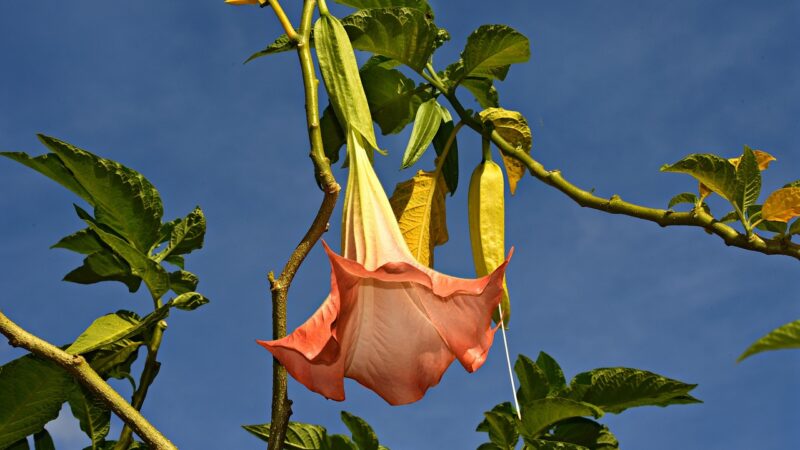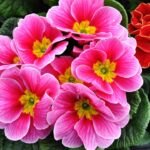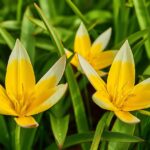Diseases and pests of angel’s trumpet

While Brugmansia are generally robust and vigorous plants, they are not immune to a range of diseases and pests that can compromise their health and detract from their ornamental beauty. A vigilant gardener who regularly inspects their plants is in the best position to catch any potential problems early, before they escalate into serious infestations or infections. The most common issues are often related to sap-sucking insects that are drawn to the plant’s lush, tender growth, and fungal diseases that can take hold in humid conditions with poor air circulation. Understanding how to identify these common adversaries and knowing the appropriate integrated pest management strategies are essential skills for maintaining a healthy, thriving angel’s trumpet. A proactive approach, focusing on prevention and early intervention, will always be more effective than trying to remedy a large-scale problem.
The primary pests that afflict Brugmansia are typically small, sap-sucking insects. These include spider mites, aphids, whiteflies, and mealybugs. They use their piercing mouthparts to feed on the nutrient-rich sap flowing through the plant’s leaves and stems, which can lead to stippling, yellowing, leaf distortion, and a general loss of vigor. Furthermore, many of these pests excrete a sticky substance called honeydew, which can lead to the secondary problem of sooty mold, a black fungus that grows on the honeydew and can interfere with photosynthesis. Regular inspection of the undersides of leaves, where these pests often congregate, is the first line of defense.
In terms of diseases, Brugmansia are most susceptible to fungal and root-related issues, which are often exacerbated by environmental factors. Powdery mildew can appear as a white, dusty coating on the leaves, particularly in humid weather with cool nights. Root rot is a more serious issue, typically caused by overwatering or poorly draining soil, which creates an anaerobic environment where pathogenic fungi and bacteria thrive. Less common, but more difficult to treat, are viral infections, which can cause mosaic patterns, streaking, and distorted growth, and are often transmitted by sap-sucking insects.
Effective management begins with creating a growing environment that is less hospitable to pests and diseases. This includes providing adequate spacing between plants to ensure good air circulation, watering the soil directly rather than the foliage, and removing any dead or diseased plant debris promptly. When pests or diseases do appear, it is often best to start with the least toxic control methods first. This can include physically removing pests with a strong spray of water, using insecticidal soaps or horticultural oils, and introducing beneficial insects that prey on the problem pests. A healthy, well-cared-for plant is also inherently more resilient and better able to withstand an attack from pests or diseases.
Identifying common insect pests
One of the most pervasive pests on Brugmansia is the two-spotted spider mite. These are not true insects but tiny arachnids that are difficult to see with the naked eye. Their presence is often first detected by the fine, silky webbing they produce on the undersides of leaves and at the junction of stems. They cause damage by piercing leaf cells to suck out their contents, resulting in a fine, yellowish or whitish stippling on the upper leaf surface. In heavy infestations, leaves can turn yellow or bronze and drop from the plant. Spider mites thrive in hot, dry conditions, so increasing humidity around the plant can help to deter them.
More articles on this topic
Aphids are another common nuisance. These are small, pear-shaped insects that can be green, black, or yellow, and they tend to cluster on new, tender growth and flower buds. They feed on plant sap, which can cause new leaves to become curled, distorted, and stunted. Like other sap-feeders, aphids excrete sticky honeydew, which attracts ants and can lead to sooty mold. Their populations can explode rapidly, so it is important to address them as soon as they are spotted. A strong jet of water from a hose can be surprisingly effective at dislodging them from the plant.
Whiteflies can be a particular problem, especially in greenhouses or warm, sheltered locations. These tiny, moth-like insects will fly up in a cloud when a plant is disturbed. Both the adults and their nymphal stages feed on plant sap, causing yellowing and a general decline in plant health. They are also prolific producers of honeydew. Whiteflies are notoriously difficult to control because the adult stage is mobile and the pupal stage is resistant to many insecticides. Repeated applications of insecticidal soap or horticultural oil are often necessary to break their life cycle.
Mealybugs and various scale insects are less common but can also become established on Brugmansia. Mealybugs appear as small, white, cottony masses, typically found in leaf axils and other protected areas. Scale insects have a hard, waxy covering and look like small bumps on the stems and leaves. Both pests are sedentary for most of their lives, feeding on sap and weakening the plant over time. They can be difficult to control with contact sprays due to their protective coverings. Dabbing individual pests with a cotton swab dipped in rubbing alcohol can be an effective spot treatment for minor infestations.
Strategies for pest management
An integrated pest management (IPM) approach is the most sustainable and effective way to deal with pests on angel’s trumpets. IPM prioritizes prevention and biological controls, resorting to chemical pesticides only when absolutely necessary. The foundation of IPM is regular monitoring. A weekly inspection of the entire plant, paying close attention to the undersides of leaves and new growth, allows for the early detection of any pest activity. Catching an infestation when it consists of only a few individuals is far easier than dealing with a full-blown population explosion.
More articles on this topic
The first line of defense is often mechanical or physical control. For pests like aphids and spider mites, a strong spray of water from a hose can physically knock them off the plant, significantly reducing their numbers. For larger pests or isolated clusters of mealybugs, manual removal by hand or with a cotton swab can be very effective. Pruning and disposing of heavily infested leaves or branches can also help to slow the spread of a pest population. These simple, non-toxic methods should always be the first course of action.
When physical controls are not enough, the next step is to use biorational or ‘soft’ pesticides. These include products like insecticidal soaps and horticultural oils (such as neem oil). These products work by smothering soft-bodied insects like aphids, mites, and whiteflies, and they have a low impact on beneficial insects, humans, and the environment. They must be applied thoroughly, ensuring complete coverage of all plant surfaces, especially the undersides of leaves where pests hide. It is important to note that these oils can cause leaf burn if applied in direct sun or high temperatures, so application during the cooler evening hours is recommended.
Encouraging beneficial insects in the garden is a powerful, long-term biological control strategy. Ladybugs, lacewings, and parasitic wasps are all natural predators of common Brugmansia pests. Planting a diversity of flowering plants nearby can help to attract and sustain populations of these helpful allies. In some cases, purchasing and releasing beneficial insects can be an effective way to control a stubborn pest problem. This approach creates a more balanced garden ecosystem where pest populations are kept in check naturally.
Recognizing common plant diseases
Root rot is one of the most serious diseases that can affect Brugmansia, and it is almost always a result of cultural practices rather than an aggressive pathogen. It is caused by soil-borne fungi that thrive in waterlogged, anaerobic conditions. The symptoms above ground can be misleading, often appearing as wilting, yellowing leaves, and stunted growth, which a gardener might misinterpret as a sign of underwatering. However, an inspection of the roots will reveal them to be brown, mushy, and foul-smelling, rather than firm and white. Prevention through the use of well-draining soil and careful water management is the only effective cure, as a plant with advanced root rot is often impossible to save.
Fungal leaf spots and blights can also occur, particularly during periods of high humidity or wet weather. These diseases typically appear as discolored spots or lesions on the leaves, which may be brown, black, or tan, and sometimes have a yellow halo. As the disease progresses, these spots may enlarge and merge, leading to premature leaf drop. Good sanitation is key to control; this includes removing and destroying affected leaves as they appear and cleaning up any fallen debris from around the base of the plant. Ensuring good air circulation by providing adequate spacing between plants can also significantly reduce the incidence of fungal issues.
Powdery mildew is a common fungal disease that is easily recognizable. It manifests as a distinctive white or grayish, powdery coating on the surfaces of leaves, stems, and sometimes flowers. While it rarely kills the plant, it is unsightly and can reduce photosynthesis, weakening the plant over time if left unchecked. Powdery mildew thrives in conditions of high humidity, particularly when days are warm and nights are cool. Improving air circulation and, if possible, reducing ambient humidity can help. Horticultural oils, neem oil, or specific fungicidal sprays can be used to treat existing infections.
Viral infections are less common but are the most difficult diseases to manage. Viruses can cause a variety of symptoms, including mosaic (mottled light and dark green patterns on leaves), leaf curling, ring spots, and severely stunted or deformed growth. There is no cure for a viral infection in a plant. Viruses are often spread from one plant to another by sap-sucking insects like aphids. Therefore, the best management strategy is prevention, which involves controlling insect vectors and immediately removing and destroying any plant that shows clear symptoms of a viral infection to prevent its spread to other healthy plants in the garden.
Preventative measures for plant health
The most effective strategy for managing diseases and pests is to focus on prevention by cultivating a strong, healthy plant that is naturally more resilient. This begins with providing the optimal growing conditions. A Brugmansia that receives the right amount of light, water, and nutrients will be vigorous and better equipped to fend off potential problems. Conversely, a plant that is stressed by drought, nutrient deficiency, or improper light exposure will be weakened and become a prime target for opportunistic pests and pathogens.
Good garden hygiene, or sanitation, is a critical preventative measure. This involves the regular removal of any dead or yellowing leaves, spent flowers, and fallen debris from the plant and the surrounding soil surface. This material can harbor pest eggs and fungal spores, and its removal eliminates a potential source of future infections. Pruning tools should always be cleaned and disinfected, especially after working on a diseased plant, to prevent the mechanical transmission of pathogens. A simple wipe with rubbing alcohol is sufficient for this purpose.
Ensuring adequate air circulation around the plant is vital for preventing many fungal diseases. This can be achieved through strategic pruning to open up the plant’s canopy and by providing sufficient spacing between the Brugmansia and any neighboring plants. Good airflow helps to reduce humidity levels within the foliage and allows leaf surfaces to dry more quickly after rain or watering, creating an environment that is less conducive to the germination of fungal spores. For plants grown indoors or in a greenhouse, using a small circulating fan can be very beneficial.
When bringing a new plant into the garden or home, it is a wise practice to quarantine it for a period of two to three weeks. This isolation allows for close observation to ensure the new plant is not carrying any hidden pests or diseases that could then spread to an established collection. During this quarantine period, inspect the new plant carefully for any signs of trouble. This simple act of biosecurity can prevent the introduction of many problematic issues, saving a great deal of effort and potential heartache down the line.
Addressing environmental and nutrient issues
Sometimes, what appears to be a disease is actually a physiological or environmental issue. Leaf scorch is a perfect example, presenting as brown, dry, or crispy patches on the edges and tips of leaves. This is not caused by a pathogen but is a result of the leaves losing water faster than the roots can supply it, often due to exposure to intense sun, hot, dry winds, or insufficient watering. The solution is cultural: provide more consistent water, move the plant to a location with afternoon shade, or erect a temporary shade cloth during heatwaves.
Nutrient deficiencies can also mimic disease symptoms. The most common is chlorosis, or the yellowing of leaves. A general, uniform yellowing, especially of older, lower leaves, often indicates a nitrogen deficiency. If the yellowing occurs between the veins while the veins themselves remain green (interveinal chlorosis), it is typically a sign of a magnesium or iron deficiency. These issues are resolved not with pesticides or fungicides, but with proper fertilization. A balanced fertilizer, supplemented with Epsom salts for magnesium, will usually correct these problems.
Edema is a physiological condition that can occur when a plant absorbs water faster than it can transpire it, often in cool, humid conditions. This excess water pressure causes cells on the undersides of the leaves to rupture, forming unsightly corky, brownish bumps or blisters. While it can look alarming, edema is not a disease and is not contagious. The condition can be managed by reducing watering frequency, increasing light levels, and improving air circulation to encourage a higher rate of transpiration, allowing the plant to achieve a better water balance.
Salt buildup in the soil, particularly in container-grown plants, can also cause health problems. The accumulation of mineral salts from fertilizers and hard tap water can damage the roots and interfere with water and nutrient uptake, leading to stunted growth and leaf burn. This issue can be prevented and remedied by periodically ‘leaching’ the pot. This involves watering the plant heavily and deeply with fresh, clean water, allowing a large volume of water to flush through the pot and carry the excess salts out through the drainage holes. This should be done every few months to maintain a healthy root environment.



















